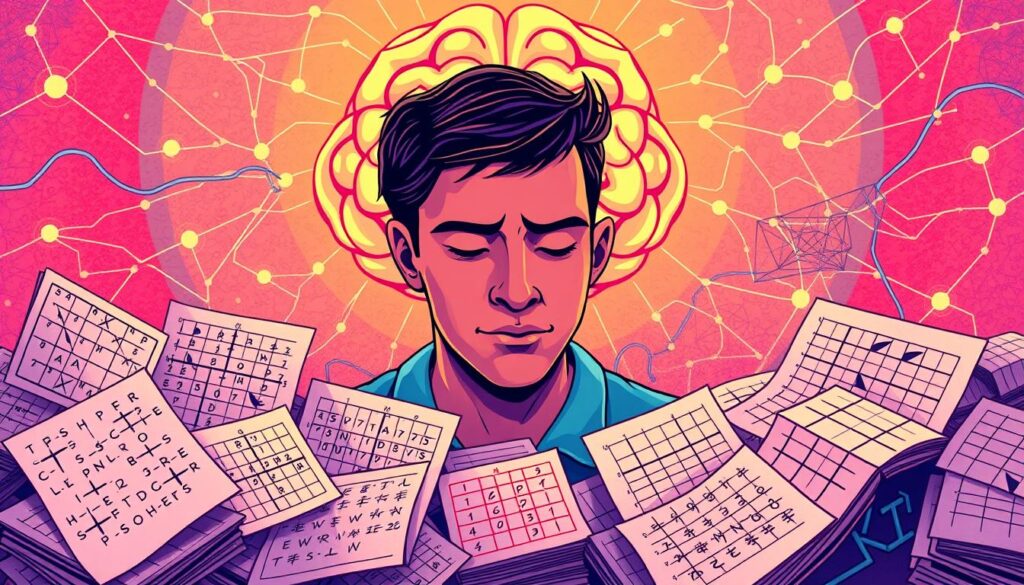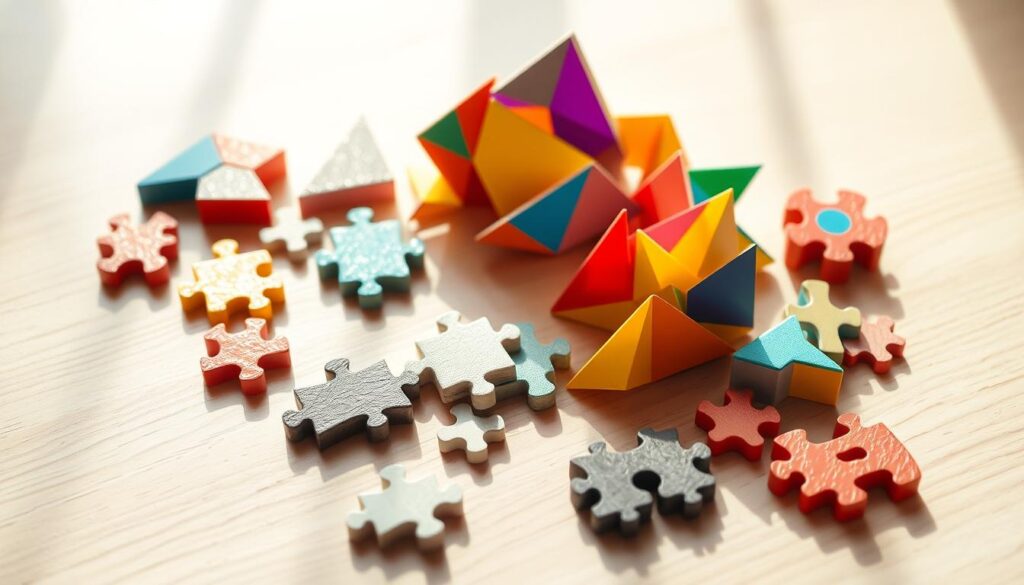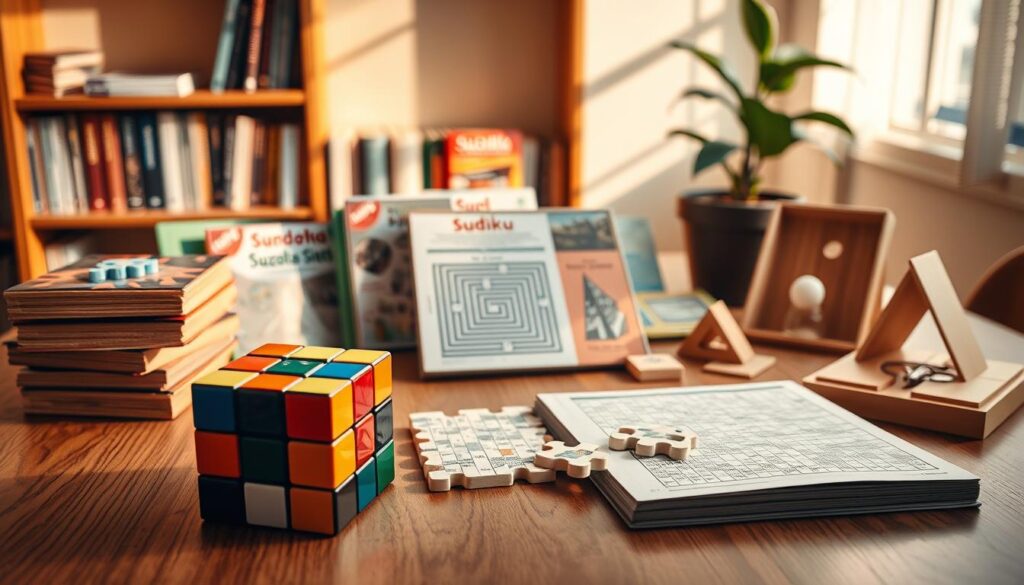Logic Puzzle Ideas for Brain Training
Did you know regular mental workouts can improve focus by up to 48%? Brain-teasing challenges aren’t just fun – they rewire neural pathways while feeling like play. Whether you’re prepping for game night or sharpening your mind, these activities offer benefits far beyond casual entertainment.
Our guide reveals how creative problem-solving games become powerful cognitive tools. Discover formats that work equally well for solo practice or group gatherings. The best part? You’ll find solutions that make even complex patterns feel approachable.
We’ve designed this resource for all skill levels. First-timers get clear explanations, while seasoned solvers find fresh twists on classic formats. Expect surprising connections between math, language, and spatial reasoning – all wrapped in engaging challenges.
Key Takeaways
- Mental exercises boost focus and cognitive flexibility
- Adaptable formats suit solo or social settings
- Solutions reveal hidden patterns in apparent chaos
- Creative approaches often outperform pure analysis
- Strategies apply to real-world problem solving
Introduction to Brain Training with Logic Puzzles

Neuroplasticity research reveals that structured mental challenges can rewire your brain’s problem-solving pathways. These exercises act like cognitive cross-training, targeting memory, attention, and reasoning simultaneously. Deductive reasoning forms the backbone of this mental workout, teaching you to draw conclusions from limited information.
Unlike traditional study methods, these activities provide instant feedback. You immediately know if your solution works, creating a clear path for improvement. This measurable progress makes it easy to track your growing skills over time.
Here’s how different brain training methods compare:
| Method | Feedback Type | Equipment Needed | Skill Developed |
|---|---|---|---|
| Mental Challenges | Immediate | None | Critical Thinking |
| Meditation | Long-term | None | Focus |
| Memory Games | Delayed | Digital Device | Recall Speed |
Regular practice strengthens neural connections through a process called myelination, where brain pathways become more efficient. Just 10 minutes daily can enhance decision-making abilities that apply to work challenges or household tasks.
This article explores accessible techniques requiring only paper and pencil. You’ll discover how structured thinking exercises transform complex problems into manageable steps. The best part? It feels more like playing a game than doing mental work.
Understanding Logic Puzzles and Their Benefits

The best brain workouts blend rule-based thinking with unexpected solutions. These activities strengthen mental muscles through structured challenges that demand both precision and imagination.
How Puzzles Enhance Cognitive Skills
Regular engagement with thought-provoking challenges sharpens multiple mental abilities simultaneously. Studies show improved pattern recognition helps people spot connections in data 37% faster than non-practitioners. This skill proves valuable when analyzing spreadsheets or planning efficient routes.
Working memory gets a boost through exercises requiring mental juggling of variables. One experiment revealed participants could track 22% more information after eight weeks of daily practice. These gains translate directly to managing complex tasks at work or home.
The Role of Creativity in Problem Solving
While rules provide framework, breakthroughs often come from sideways thinking. “The ‘aha’ moment usually arrives when we relax rigid assumptions,” notes cognitive researcher Dr. Ellen Torres. This dance between structure and innovation mirrors real-world challenges like budget planning or event coordination.
Brain scans reveal increased connectivity between analytical and creative regions in frequent solvers. This neural teamwork enhances adaptability – crucial when facing unexpected obstacles. The next time you’re stuck, try sketching ideas instead of over-analyzing. You might surprise yourself with what emerges.
Logic Puzzle Ideas to Boost Brainpower

What makes certain activities stand out in cognitive development? The answer lies in strategic variety. Modern brain training combines time-tested formats with digital innovations, creating workouts that feel fresh yet effective.
Blending Old and New Formats
Classic number games like Sudoku now share space with app-based escape rooms. Both formats test deduction skills but through different interfaces. Paper-based challenges improve spatial reasoning, while digital versions often enhance reaction time.
Consider these popular categories and their benefits:
| Category | Skills Developed | Tools Needed | Engagement Level |
|---|---|---|---|
| Riddles | Lateral Thinking | None | High (Group) |
| Grid Problems | Pattern Recognition | Pen/Paper | Moderate (Solo) |
| App Challenges | Multitasking | Smartphone | Variable |
“The magic happens when analog and digital formats cross-pollinate,” says cognitive scientist Dr. Mara Lin. This mix prevents mental fatigue while building diverse skills. Rotate between quick mobile games and in-depth paper challenges for balanced training.
Difficulty customization keeps progress steady. Beginners might start with visual matching games, while experts tackle layered deduction problems. Most apps now offer adaptive algorithms that adjust to your skill level automatically.
By combining tactile experiences with tech-enhanced feedback, you create personalized workouts. This approach respects individual learning styles while pushing cognitive boundaries. The key? Keep switching formats before any routine becomes predictable.
Exploring Classic Puzzle Examples

Ever wondered how to transport four people across a river with just one torch? This brain-twister reveals how constraints spark creative solutions. Let’s explore Richard Hovasse’s iconic bridge challenge that’s stumped – and enlightened – thinkers for decades.
River Crossing and Bridge Problems
Hovasse’s scenario pits four individuals against time and darkness. With a bridge that only holds two people and a single torch, every decision counts. The twist? Slower walkers dictate pair speeds, forcing players to balance speed with teamwork.
| Puzzle Type | Key Constraints | Skills Tested | Solution Time |
|---|---|---|---|
| Classic Bridge | Torch limit, capacity rules | Resource optimization | 15 minutes |
| Modern Variation | Multiple items, language barriers | Multitasking | 18-25 minutes |
The optimal solution requires strategic planning across five trips. First, the fastest pair crosses (2 minutes). One returns with the torch (1 minute). Then the slowest duo crosses (8 minutes), followed by the second-fastest returnee (2 minutes). Finally, the remaining pair crosses (2 minutes). Total? Exactly 15 minutes.
These challenges teach real-world skills like bottleneck identification and priority sequencing. “What seems impossible becomes manageable when broken into steps,” notes puzzle designer Carla Mendez. Variations might swap torches for flashlights or add cargo limits, keeping the format fresh.
Beyond entertainment, these exercises sharpen workplace abilities. Project managers use similar methods to allocate team resources. Parents apply the principles when coordinating family schedules. The bridge isn’t just wooden planks – it’s a metaphor for life’s constrained choices.
Unraveling Brain Teasers and Riddles

Ever solved a riddle that made you question your own math skills? Take the classic restaurant bill challenge: You pay €100 for a €97 meal, get €3 change, then tip €2. Where did the “missing” euro go? This mind-bender reveals how wording manipulates our assumptions about money flow.
Another stumper: Why does a man exit the elevator on floor 7 when he lives on 10? The answer lies in physical limitations – he can’t reach higher buttons! These brain teasers train us to spot hidden constraints in everyday scenarios.
Effective solving strategies include:
- Highlighting numerical relationships in word problems
- Visualizing spatial setups for situational challenges
- Testing multiple interpretations of key phrases
| Riddle Type | Common Trap | Solution Approach | Real-World Application |
|---|---|---|---|
| Mathematical Misdirection | False equivalence | Track all transactions | Budget analysis |
| Situational Constraints | Overlooked details | Recreate scenario | Process optimization |
Regular practice with questions like these builds pattern-spotting abilities. You’ll start noticing assumptions in work emails or contract terms faster. As Dr. Lisa Tan, cognitive researcher, notes: “Riddles teach us to read between the lines – a skill that prevents costly misunderstandings.”
Try rewriting tricky riddles in your own words. This exposes hidden clues and strengthens communication skills. The more you engage with these challenges, the better you’ll become at decoding complex instructions or spotting loopholes.
Puzzle Strategies: Elimination Grids and Syllogisms

Complex matching problems become solvable when you organize clues visually. Elimination grids turn chaotic information into clear pathways. Picture a chart where each row shows possible options, and columns track potential matches. This system helps eliminate wrong answers methodically.
Let’s say you need to match four persons with their favorite colors. Create a grid with names in rows and colors in columns. Cross out impossible matches as clues emerge. For example: “Alex doesn’t like blue” removes one cell. Gradually, the correct pairings become obvious.
Syllogisms take a different approach. These reasoning exercises use statements to reach conclusions. Consider: “All puzzles improve focus. Some focus exercises use grids. Therefore…” This structured thinking trains your brain to connect ideas logically.
Effective grid use involves three steps:
- List all possible combinations
- Mark definite exclusions first
- Update remaining options as new clues appear
These methods reduce mental strain by externalizing information. “Your working memory has limited space,” explains cognitive coach Mark Terrell. Visual tools free up brainpower for actual problem-solving.
Real-world applications abound. Project managers use modified grids to assign tasks. Parents apply syllogistic thinking when planning schedules. The skills transfer seamlessly to any situation requiring organized analysis.
Truth Tellers and Liars: Knights and Knaves Puzzles
Imagine standing before two doors guarded by mysterious figures. One leads to safety, the other to danger. This scenario forms the core of knights and knaves challenges made famous by Raymond Smullyan. The twist? One guard always tells the truth, while the other consistently lies – but you don’t know which is which.
Key Principles in Deductive Reasoning
These puzzles teach you to craft questions that work regardless of who answers. The classic solution asks one guard: “What would the other guard say is the safe door?” Then you choose the opposite. This self-referential approach bypasses deception by using the liar’s nature against them.
| Approach | Question Type | Effect |
|---|---|---|
| Direct Inquiry | “Which door leads out?” | Unreliable |
| Reflective Question | “What would they say?” | Reveals truth through lies |
Effective Approaches to Solve the Puzzles
Modern variations add complexity – multiple guards with mixed truth patterns or time-sensitive conditions. Try these strategies:
- Frame questions about what others would claim
- Use hypothetical scenarios to expose inconsistencies
- Track verbal patterns across multiple exchanges
These exercises sharpen real-world negotiation skills. As security expert Dr. Nora Chen notes: “In crisis situations, identifying reliable information sources becomes survival-critical.” The same principles help evaluate news sources or assess conflicting advice.
Arithmetic Challenges and Cryptogram Conundrums
Numbers transform into secret codes waiting to be cracked. Arithmetic challenges blend math skills with detective work, turning equations into treasure hunts for hidden patterns. Cryptogram conundrums take this further by swapping digits for letters, creating layered mysteries that demand both calculation and creativity.
Take the classic SEND + MORE = MONEY puzzle. Each letter represents a unique digit. Solvers must deduce values through trial and elimination. Start with the leftmost letters – since M becomes 1 in most solutions (carry-over rules). This systematic approach builds algebraic thinking without formal equations.
Effective strategies for these number games include:
- Identifying columns with obvious digit relationships
- Tracking which letters can’t be zero
- Testing possible values for high-frequency characters first
| Puzzle Type | Core Skill | Real-World Use |
|---|---|---|
| Arithmetic Fill-Ins | Operation fluency | Budget balancing |
| Cryptograms | Variable analysis | Data decryption |
Teachers often use these formats to make math concepts tangible. “Students stop fearing variables when they see them as puzzle pieces,” notes middle school STEM coordinator Rachel Nguyen. Office managers report faster error-spotting in spreadsheets after regular practice.
For tricky challenges, try rewriting equations vertically. This visual trick reveals carry-over clues missed in horizontal layouts. The key? Treat numbers as flexible partners rather than fixed values – a mindset that improves mental math speed and accuracy.
Creative Chess Puzzles and Nonogram Mysteries
What do ancient board games and modern pixel art have in common? Both can become powerful tools for mental growth when transformed into strategic challenges. Chess-based brain games and number-guided grids offer unique ways to sharpen decision-making skills while creating visual masterpieces.
Mastering Movement Patterns
Chess tours test your ability to navigate the board using piece-specific rules. The knight’s tour, for example, requires visiting every square without repeats. This exercise improves spatial awareness and teaches efficient path planning – skills useful in logistics or interior design.
Nonograms reveal hidden images through numerical clues. Each row and column number indicates consecutive filled squares. Start by marking definite blocks, then eliminate impossible spaces. The process combines deductive reasoning with artistic revelation.
| Challenge Type | Grid Format | Core Skills | Average Solve Time |
|---|---|---|---|
| Chess Tours | 8×8 Board | Strategic Planning | 20-45 minutes |
| Nonograms | 15×15 Grid | Pattern Analysis | 30-60 minutes |
Regular practice with these formats enhances real-world abilities. Chess players report better multitasking at work, while nonogram enthusiasts notice improved attention to detail. “The satisfaction comes from seeing chaos become order – then art,” explains game designer Elena Rodriguez.
Both activities reward systematic thinking but through different approaches. Chess challenges demand forward-thinking strategies, while nonograms require meticulous backward elimination. Together, they create a balanced cognitive workout that feels more like play than practice.
Mystery Tour and Maze Puzzle Techniques
Ever traced a path through a maze and discovered hidden shortcuts? Tour challenges test your ability to map efficient routes through complex networks. These puzzles work like navigating a city with one-way streets – every turn reveals new constraints and possibilities.
In this type of brain game, you might guide a character through winding corridors or connect dots without retracing steps. The goal? Find the optimal way to cover all required points. Start by marking dead ends first – this strategy quickly narrows your options.
Modern variations blend physical mazes with digital interfaces. Some apps let you rotate labyrinth walls mid-solve, adding real-time problem-solving layers. Others use color-coding to represent multiple solution paths within single grids.
These techniques sharpen spatial reasoning for everyday tasks. Delivery drivers use similar methods to optimize routes. Event planners apply maze-solving principles when arranging vendor booths. The skills translate surprisingly well to organizing cluttered closets or packed schedules.
For best results, alternate between timed speed runs and relaxed exploration. This balance builds quick thinking alongside strategic planning – a combination that turns chaotic paths into clear roadmaps.
FAQ
How do brain-training challenges improve cognitive skills?
What are classic examples of beginner-friendly challenges?
What strategies work best for complex riddles?
How do knights and knaves scenarios test reasoning?
What’s the difference between arithmetic challenges and cryptograms?
How do chess tours improve strategic planning?
Why is creativity important in solving these problems?

Adam Peter is a finance, travel, and automotive writer with over a decade of experience. He creates clear, practical content to help readers manage their money, explore the world with confidence, and make informed decisions about cars and travel gear. His work blends expert insight with real-world usefulness.




